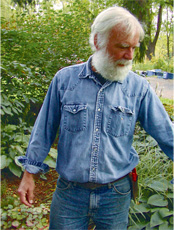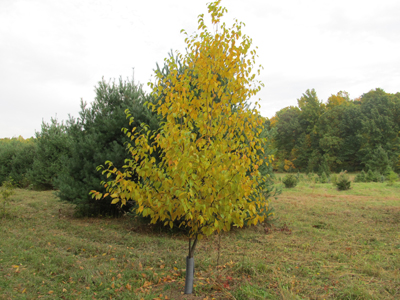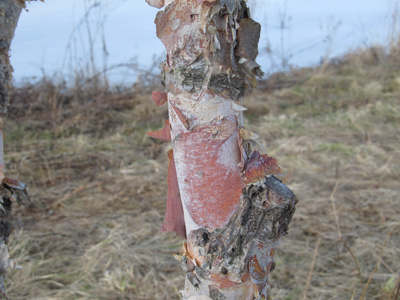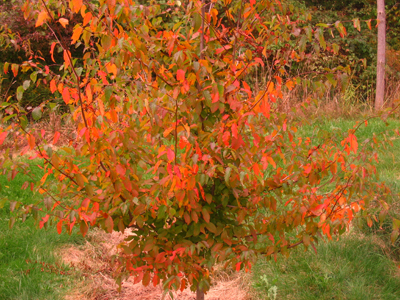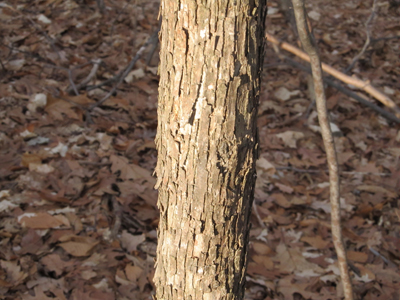Story and images by Andrew Fowler
Birches (Betula spp.) are among the most cold-hardy of deciduous trees, being natives of the northern boreal forests alongside firs and spruces. During the glacial periods, birches remained close to the glaciers’ edges, and once those glaciers retreated birches became the pioneer species. Today they prove themselves good colonizers of disturbed soils, highway cuts and abandoned agricultural fields, and can serve as nurse trees for other species. They are usually short-lived, except perhaps for the yellow birch (B. alleghaniensis), which maintains its presence with beech and maple among climax forest communities along the Appalachian chain and throughout the northeast and Great Lakes.
Birches are noted for their colorful, peeling bark, with white being the most commonly associated feature. It was this asset that brought birches into the gardeners’ world—unfortunately, the European white birch (B. pendula) became the birch of choice, while the native species were all but ignored. The problem with most birches is that they are denizens of cold northern forests, and placing them in manicured landscapes and lawns is almost inevitably going to stress them. The European white birch soon proved to be highly susceptible to the bronze birch borer, a native beetle that feeds on the cambium of stressed trees and generally proves fatal. The native paper birch (B. papyrifera), also a white-barked species, is less susceptible to the beetle. However, this species likes a cool, moist acid soil, a rare commodity in most landscapes. The determining factor in bronze birch borer resistance is the presence of the chemical rhododendrol, produced in stressed and dying bark tissue in all white-barked species of birch, which is a strong attractant to egg-laying female borers. There are two native birches that do not produce rhododendrol and are thus resistant to the borer: the sweet birch (B. lenta) and the river birch (B. nigra). Leaf miners are also a major problem on white-barked species, but not for sweet and river birch.
All birches have alternate, ovate, pointed leaves with finely serrated margins on thin reddish-brown branches. Fall color is usually a golden yellow. All are monoecious with separate male and female flowers formed in the fall but remaining tight until spring. The female flowers are upright and enclosed in a bud. When open they look like small cones. Male catkins are pendulous and clearly visible through winter, looking like little tails hanging from the branch tips. Flowering takes place in April, when the catkins expand and open to shed the pollen, which is windborne and can be an allergen for some people. The seeds are small and winged and are dispersed during the winter as the small cones disintegrate.
Birches prefer moist acid soils that remain fairly cool. They have fibrous root systems, which makes for easy transplanting. Fall transplanting is not recommended, however, because their thin bark and abundant twigs make water conservation through the winter difficult. Transplanting in the spring before bud break is the best time. However, they readily sprout from the base if cut down, and can be rejuvenated this way.
Birches are “bleeders” and should not be pruned in late winter or spring, but rather right after leaf drop in the fall. They can be tapped in the spring for their sap, which is used to make birch beer. Often frozen sap can be found during the winter months hanging from storm-broken twigs, and these make good popsicles.
As mentioned above, the white-barked species are particularly prone to problems due to environmental stress, notably attacks by birch bark borer and birch leaf miner. However, there are two species, native to the eastern United States, which are fairly resistant to both pests. These are the sweet birch (B. lenta), also known as cherry birch or black birch, and river birch (B. nigra).
Native from New York to Maine and down the Appalachian chain to Georgia, the sweet birch is hardy to Zone 3, and is better adapted to cultivation in warmer climes than the white-barked species. This species is a fast grower and reaches a height of perhaps 50’ and a span of 35’, and is distinctly upright in youth. The bark is a rich red-brown with prominent horizontal lenticels, reminiscent of cherry bark, becoming almost black and scaly with age. The young stems are thin and reddish brown and strongly smell and taste of wintergreen when bruised or chewed, which makes for easy identification. Yellow birch (B. alleghaniensis) also has a wintergreen odor but is not nearly as strong. The leaves of sweet birch are ovate, sharp pointed and finely serrated. Glossy green in summer, they turn a rich golden yellow in the fall, perhaps the best of all the birch leaves for fall color. The male flowers form in the fall and persist through winter hanging from the terminals, expanding and opening in April before or with the unfurling leaves. The pistillate flowers are held upright lower on the branches and open in time to receive pollen in the spring. The pistillate flowers develop through the summer into strobiles, resembling small cones, holding the small winged nutlets, which are dispersed through the winter.
This species does well on moist, fertile, acidic soils with good drainage, but will also tolerate dry soils once established. Full sun is best but it will also tolerate a modicum of shade. Poorly drained soils should be avoided.
The lack of papery, peeling bark has relegated this species to obscurity, resulting in a complete lack of cultivars, but I find it has a charm of its own, and certainly has the best fall color of any birch. It is definitely worthy of more attention.
The river birch is the only birch native to the warmer regions of the eastern United States, ranging from Massachusetts to Florida and west to Texas. It is a denizen of riverbanks and floodplains subject to periodic flooding. This makes it a good choice for wet areas of the landscape, but the species can also tolerate dry soils, at least for short periods. Its heat tolerance also makes it more easily incorporated into urban landscapes. Soils should be on the acidic side, or chlorosis can develop. The bark of this species is creamy and shiny on young stems, becoming papery thin and peeling off in curls, revealing pinkish and orange red patches underneath. It is perhaps the most colorful of the birches. The leaves are wedge-shaped, coarsely serrate or lobed, and pointed. The fall color is yellow, but is rather dull compared to the sweet birch, and the leaves often drop very early. It grows quickly to a mature height of about 60’, being pyramidal in youth. It is commonly multi-trunked, which serves to show off the bark.
Because of the widespread adaptability of the species, there are a number of cultivars now available. Probably the most frequently encountered is Heritage® (‘Cully’), which is a patented selection from Heritage Trees Inc. of Illinois. It displays increased vigor, with larger, glossier leaves and whiter bark than the average river birch. Other notable cultivars are Fox Valley® (‘Little King’), a compact, bushier grower to about 15’, and ‘Shiloh Splash,’ a variegated shrubby form to about 10’, with white edges to the leaves.
Like sweet birch, river birch is essentially immune to birch bark borer and highly resistant to leaf miner, and makes an excellent landscape specimen. Of course, as with any monoculture, the more they are planted, the more likely a pathogen is to appear. Diversity in the landscape is the key.
There are a few other members of the birch family (Betulaceae) worth considering for the garden. These include hornbeam (Carpinus spp.), and hophornbeam (Ostrya spp.).
The most common hornbeam in landscapes is the European or common hornbeam (C. betulus). Long used in Europe for hedges and screens, it takes pruning very well and is sometimes pleached into pergolas and arbors. It retains its brown dead leaves through winter, like the European beech (Fagus sylvatica), thus adding to its value as a screen. The fastigiate varieties are also highly prized. The native American hornbeam (C. caroliniana), on the other hand, is virtually ignored by the gardening public, while offering many of the same features as the European species. Native to the eastern half of the United States from the Great Lakes to Florida and hardy to Zone 3, the American hornbeam also goes by the names musclewood, blue beech and ironwood. An understory species of wooded lower slopes and floodplains and commonly associated with witch-hazel (Hamamelis virginiana), it is usually a multi-stemmed tree that can reach 30’, but can be trained as a single trunk. The stems have a fluted sinuous look, resembling well-muscled arms, and the smooth blue-gray bark accentuates this. The leaves are ovate and pointed with a doubly serrate margin. New leaves tend to be bronzy to reddish, becoming dark green in summer and turning yellow, orange and red in the fall. It has better autumn color than the European species, but does not hold its dead leaves through the winter.
The male flowers are in catkins hanging from the tips of twigs, like birches. Female flowers are low on the branches and are short, each ovary set in a papery three-lobed bract. These become nutlets arranged in a hanging infructescence, 2 to 4” long, which resemble hop fruits. The fruits gradually disintegrate through winter, spreading their papery seeds.
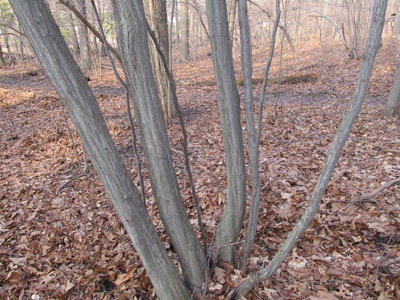 The wood is very hard and was used to make tool handles and mallet heads. It can be polished very smooth to resemble horn. The name hornbeam probably derives from this characteristic, while “beam” comes from the German word “baum,” meaning tree.
The wood is very hard and was used to make tool handles and mallet heads. It can be polished very smooth to resemble horn. The name hornbeam probably derives from this characteristic, while “beam” comes from the German word “baum,” meaning tree.
Hornbeams like deep moist acidic soils, even seasonal wet sites, but can adapt to drier soils and those with a higher pH. Although shade-growing in nature, they can also grow in full sun, where they will be much fuller branched. Generally, they are pest-free, although fusarium cankers can be an issue with stressed trees. They have a deep, coarse root system, consequently fall transplanting is not recommended; springtime is best. A delightful small native species, the American hornbeam deserves more attention from gardeners.
In the same woods as the American hornbeam, in the higher, drier slopes, the hornbeam disappears and American hophornbeam (Ostrya virginiana), the other ironwood, appears. Covering the same geographic range as the hornbeam and hardy to Zone 4 (possibly 3), the hophornbeam is usually a single trunk, growing straight and tall to about 40’. Unlike the smooth gray bark of hornbeam, the bark of hophornbeam is shiny dark brown on young stems and shaggy gray on older trunks, which makes for easy identification. The leaves are similar to birch and hornbeam, although a little wider, with doubly serrate edges. The fall color is a muted yellow and rarely effective. The flowers are like those of the other species discussed, with male catkins, grouped in threes, hanging from the tips and smaller female flowers hidden below in the foliage. In the fall, a nutlet is formed, enclosed in a papery pod, several being strung together to resemble the fruit of hops; hence the common name. These dry and persist through much of the winter and can also be used to identify the tree. The fruits have tiny hairs, which can irritate the skin.
Like the birches and hornbeams, the hophornbeam is a bleeder, so pruning should be done in fall or winter. Like most trees, moist acidic soils are preferred, but the hophornbeam can also tolerate dry soils. It’s a tap-rooted species, so container-grown trees are easier to establish. Full sun will produce a dense canopy, while in shady situations an airy open structure is more usual. The wood is extremely hard and strong, resistant to ice storm damage, and has been used for making airplane propellers and sleigh runners. Hophornbeam makes for a tough, dependable small tree, with very few pest problems
The birch family provides opportunities for most garden situations, from dry shade to open sunny areas and even wet soils. Winter interest is available in the colorful barks of some species and the hanging catkins. Fall colors come in reds, oranges and yellows. The fruits of these species provide food for small birds, such as chickadees, and small mammals.
Andrew Fowler operates Holmes Hollow Farm nursery and Christmas tree farm in Victor, NY.
Views: 0



